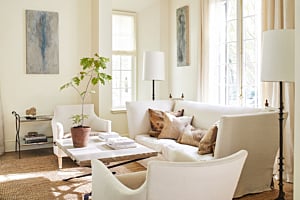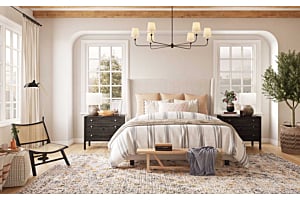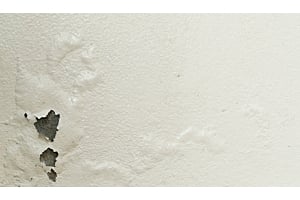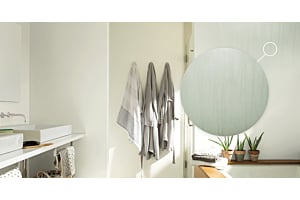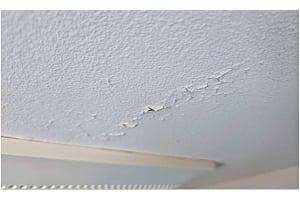The Best Ceiling Paint Color Ideas & Trends
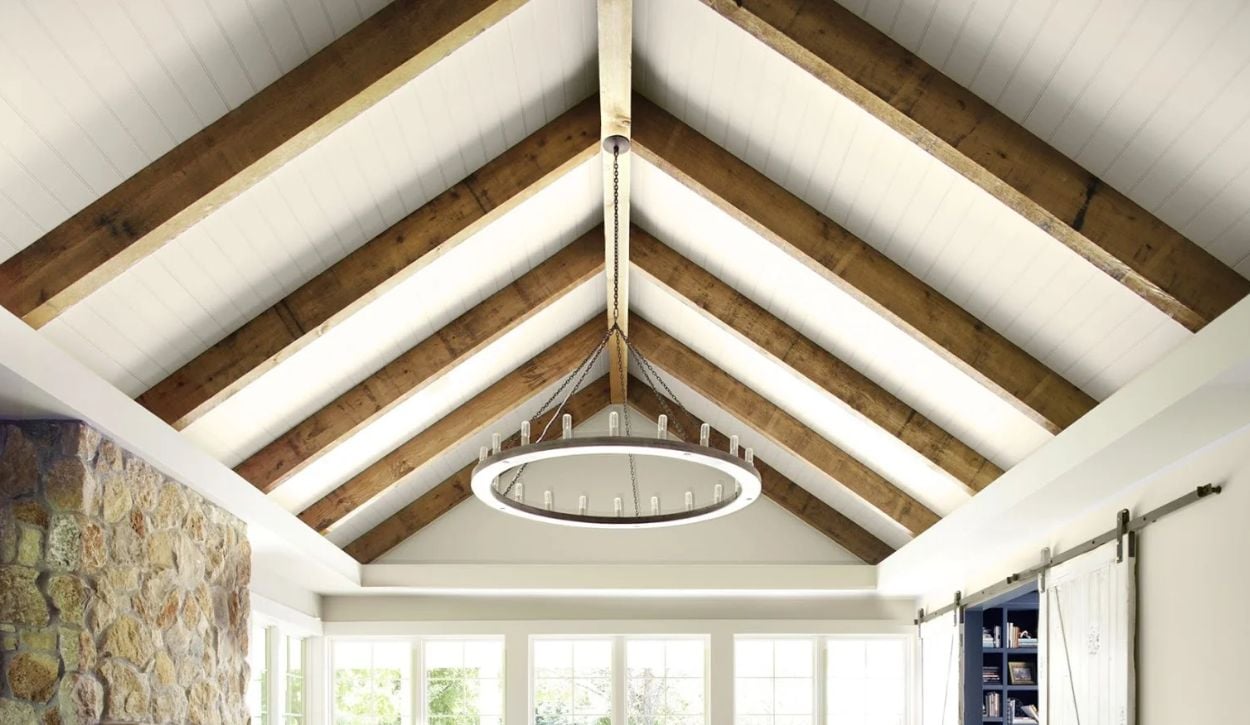
A fresh coat of paint on your ceiling can transform the entire aesthetic of your space! Classic whites like Benjamin Moore’s Chantilly Lace or Decorator’s White are the most popular ceiling colors, but there are so many interesting ceiling paint colors that draw the eye upward and add an element of surprise. Your ceiling is your ‘fifth wall’ — don’t be afraid to get creative and look for colors that will create a unique statement in your home!
From warmer neutrals to moody darks, we’ve rounded up some of our favorite painted ceiling ideas — whether you’re painting a living room, dining room, bedroom, or anywhere else.
Vaulted Ceiling Paint Ideas
A vaulted ceiling is supported by arches or beams that follow the roofline, creating a tall, airy and open space.
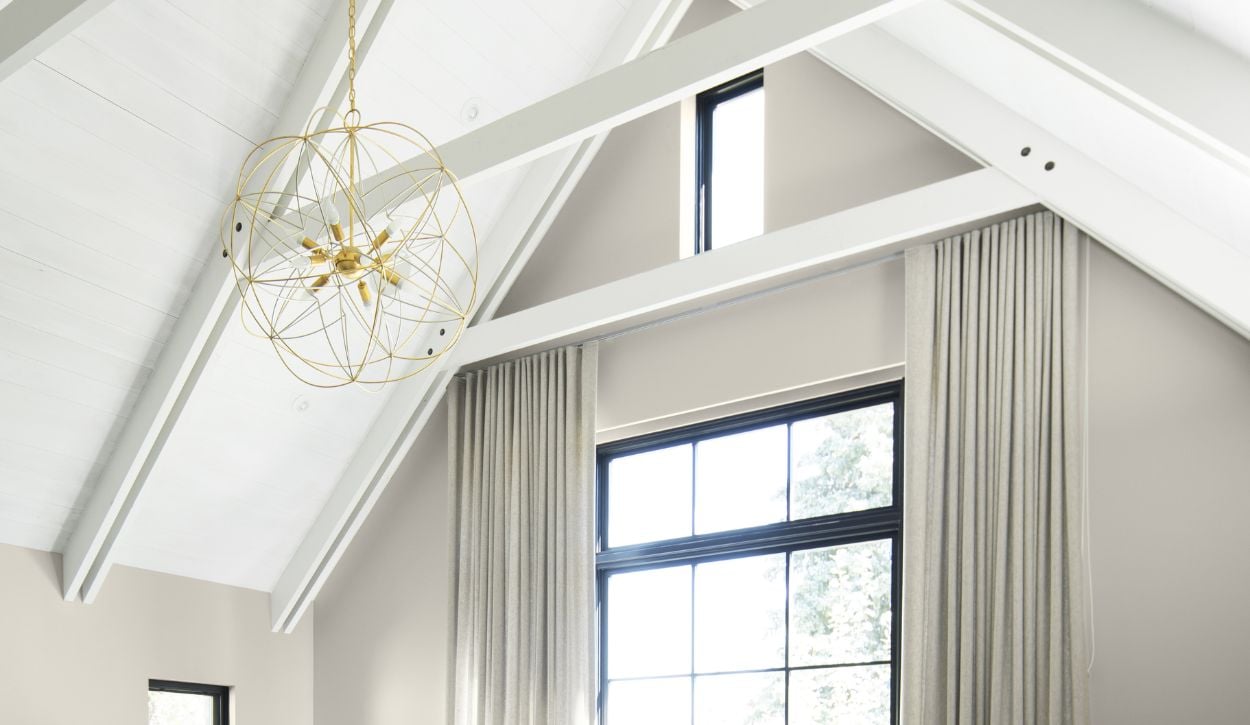
Neutral white paint colors like Benjamin Moore’s Baby's Breath or Simply White are popular for high ceilings because they amplify the light and make the space feel brighter.
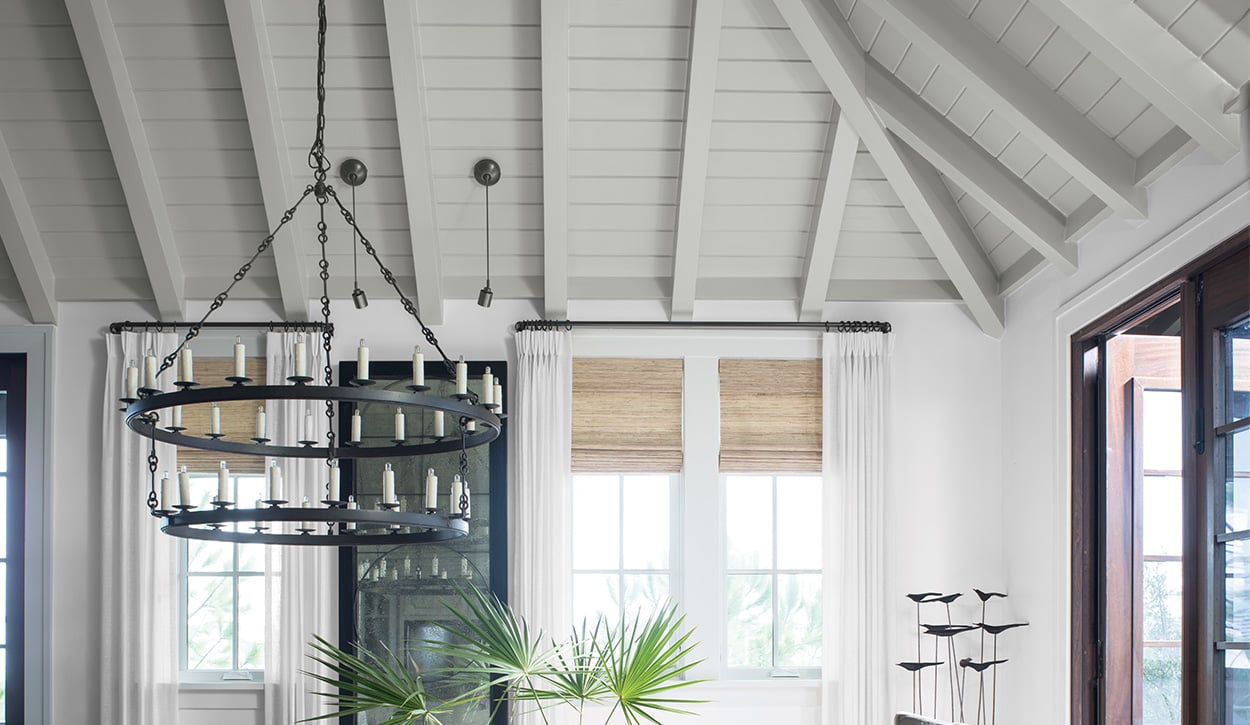 Dining room ceiling painted in Benjamin Moore Cement Gray
Dining room ceiling painted in Benjamin Moore Cement GrayPale blue shades give vaulted ceilings the serene, airy look of a summer sky. A light gray shade, like Cement Gray, looks crisp and modern. This slightly cool hue may appear warmer depending on the lighting, shifting throughout the day to create a soothing ambiance.
Slanted Ceiling Paint Ideas
A slanted ceiling is a unique architectural feature that adds character and drama. While white paint is a popular color choice, many homeowners enjoy unique colors that make a statement.
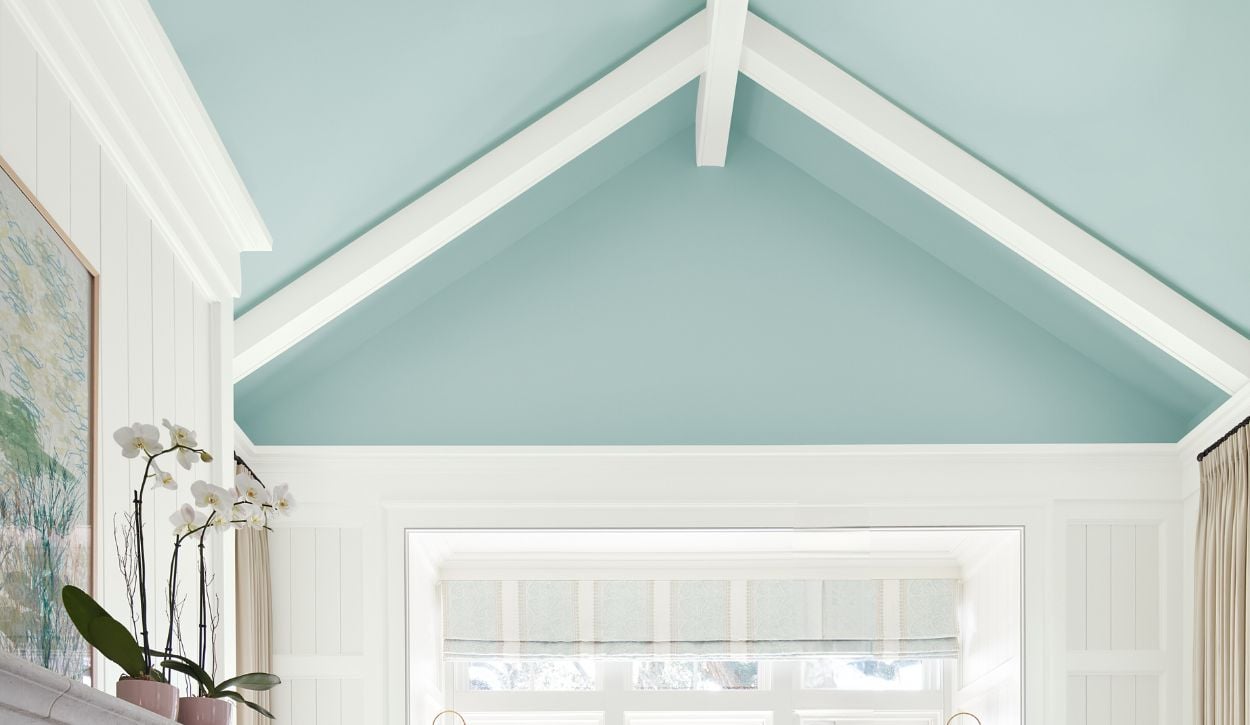 Slanted ceiling painted Benjamin Moore Heavenly Blue
Slanted ceiling painted Benjamin Moore Heavenly BlueLight colors help to accentuate the height of tall slanted ceilings. In this airy bedroom, a sky blue ceiling draws the eye upward.
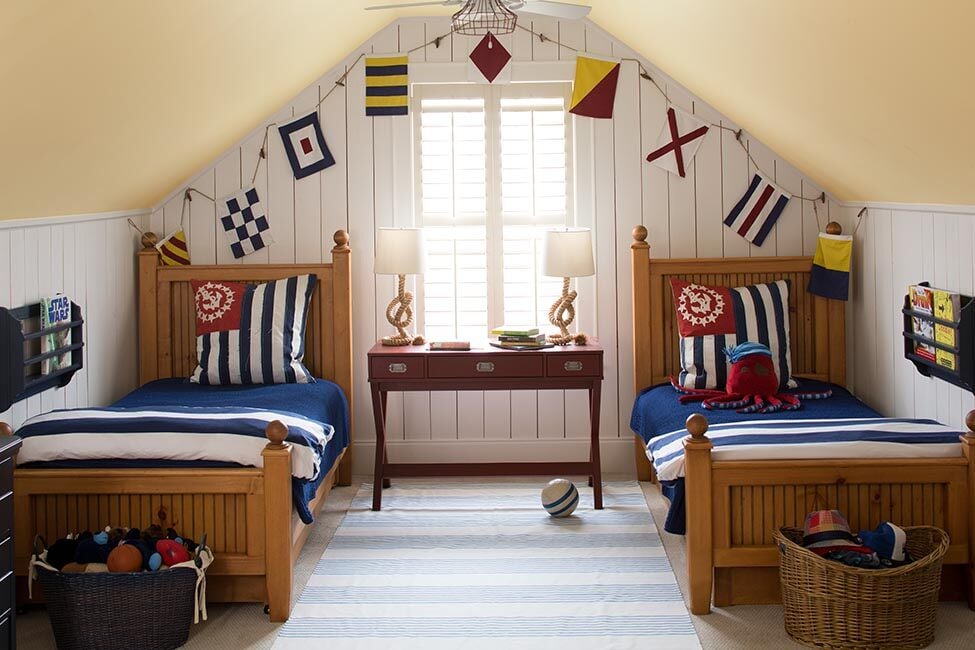 Slanted ceiling painted in Benjamin Moore Subtle AF-310
Slanted ceiling painted in Benjamin Moore Subtle AF-310Many rooms with slanted ceilings are on upper floors, and the ceilings are low. Making a statement with color is a great way to accentuate the architecture, rather than painting it all white in an attempt to disguise awkward angles. This bedroom exudes nautical charm with its plank walls and sunny yellow ceiling.
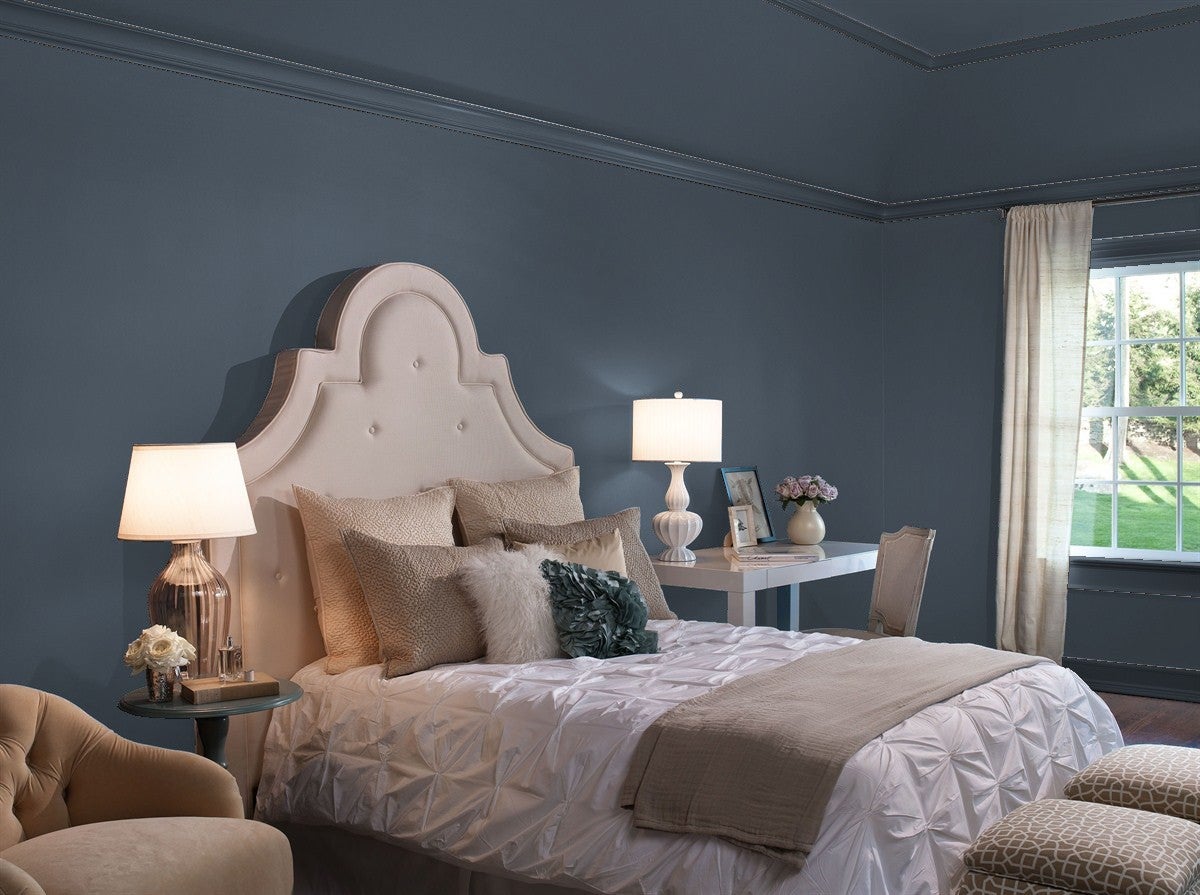 Bedroom ceiling and walls painted in Benjamin Moore Hale Navy
Bedroom ceiling and walls painted in Benjamin Moore Hale Navy Another option for painting awkward slanted ceilings is to choose a dark color for both walls and ceiling. Dark gray and blue shades like Hale Navy or Ashland Slate make the edges of a room recede. In this bedroom, Hale Navy on walls and trim unifies the space, making the slanted ceiling appear taller.
Tray Ceiling Paint Ideas
Tray ceilings can be confusing to paint because they have both horizontal and vertical surfaces. While professional painters often advise painting all vertical surfaces to match the wall color, this gives tray ceilings a “striped” look, with a strip of wall color between two white ceiling areas. If you’d like your wall color to continue up into the tray area, just paint the ceiling around the tray the same color as the wall! Now the central tray is the focal point.
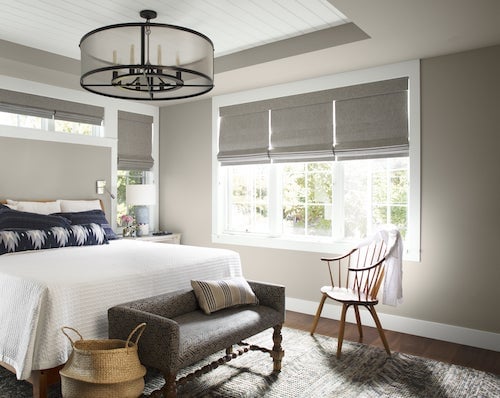 Tray ceiling painted in Benjamin Moore Silver Fox
Tray ceiling painted in Benjamin Moore Silver FoxWhite is probably the most common tray ceiling paint color, but there are many different color schemes that enhance this elegant feature. Paint the central tray a bronze shade for Old World elegance, or a pale silvery gray like Silver Satin for a touch of modern glam.
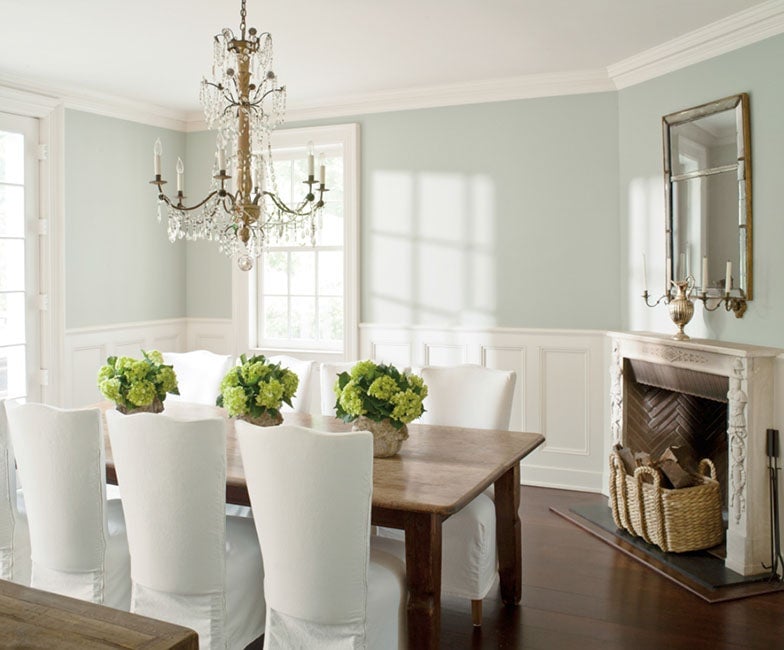
Pale sky blue is a popular tray ceiling paint color for its light and airy effect. A light blue tray ceiling is a beautiful complement to white walls, which help draw the eye upward and reflect daylight around the room. Two of our favorite light blue paint colors for ceilings are Benjamin Moore Palladian Blue and Wythe Blue.
Coffered Ceiling Paint Ideas
If you are lucky enough to have a house with a coffered ceiling you’ll want to make the most of this stunning architectural feature. Coffered ceilings use decorative beams to create a ceiling grid of three-dimensional, recessed panels. Historic buildings often have coffered ceilings in complex patterns of squares and octagons, accented by ornate carvings or plasterwork.
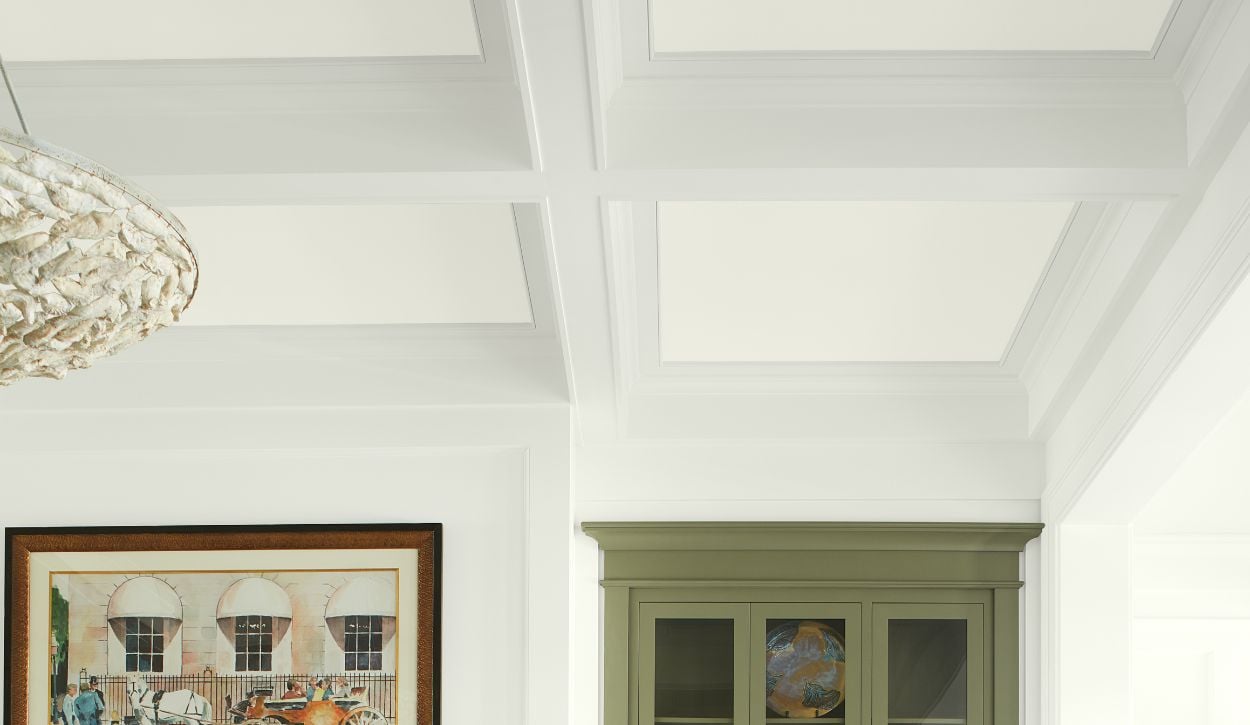 Coffered ceiling panels painted in Benjamin Moore Cloud Nine with trim in Snowfall White
Coffered ceiling panels painted in Benjamin Moore Cloud Nine with trim in Snowfall WhiteToday’s homes typically use coffered ceilings with a square pattern to add an elegant, traditional touch to living rooms. The beams are trimmed in molding, and typically painted a classic white color like Chantilly Lace.
Alternatively, consider painting the recessed ceiling panels in your coffered ceiling a contrasting color, or even wallpapering them. Adding color and pattern to the ceiling warms up a large room, and makes a small space feel more cozy and intimate!
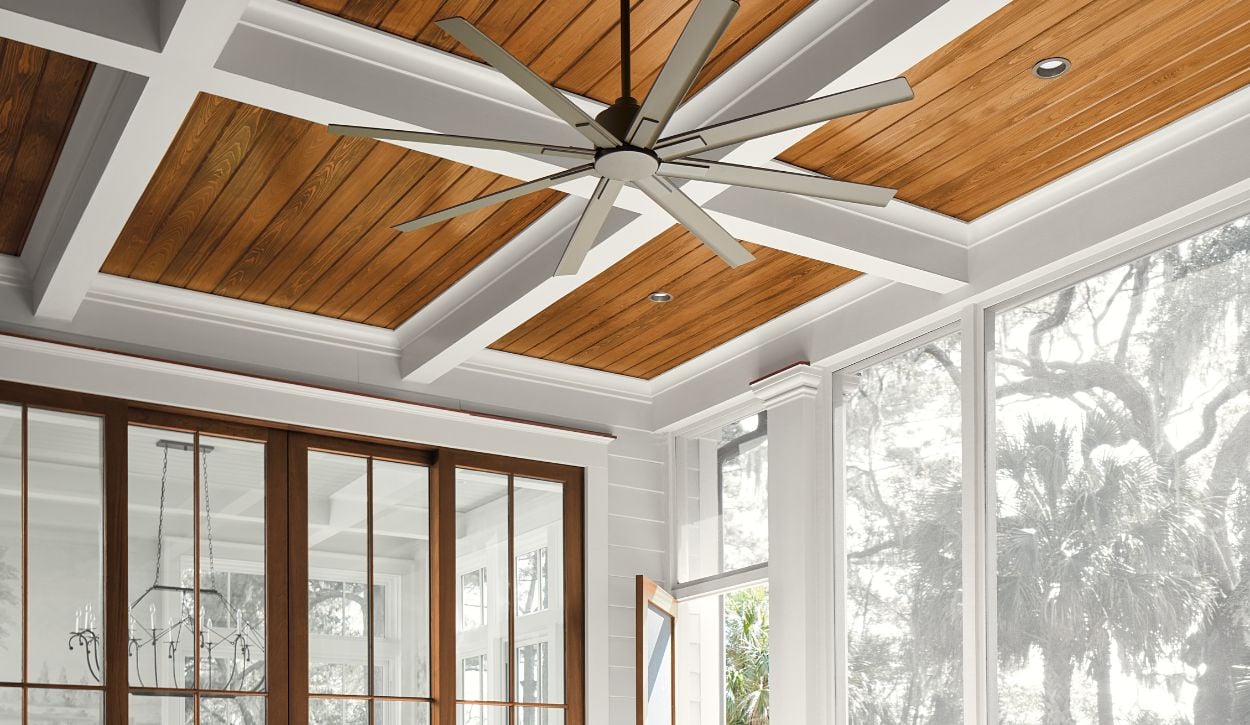 Porch ceiling stained in Woodluxe Alabaster OC-129, WB Solid Stain and Woodluxe Teak ES-30, WB Translucent
Porch ceiling stained in Woodluxe Alabaster OC-129, WB Solid Stain and Woodluxe Teak ES-30, WB TranslucentThis porch, stained with Benjamin Moore’s premium Woodluxe waterborne stains, uses classic white trim to enhance the beauty of natural wood.
Paint Ideas for Ceilings with Exposed Beams
Exposed beam ceilings feature the rustic warmth of natural wood. This architectural detail gives your space an industrial or historic touch.
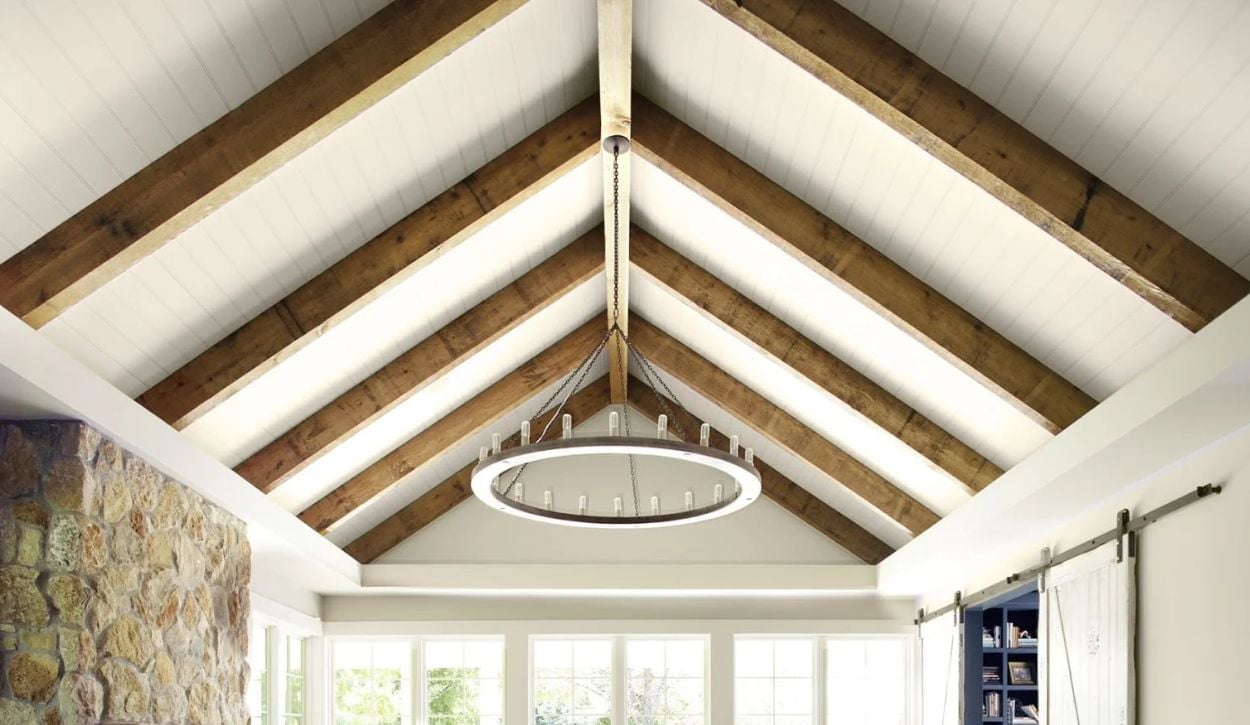 Benjamin Moore Pale Oak on an exposed beam ceiling
Benjamin Moore Pale Oak on an exposed beam ceilingNature-inspired ceiling colors like sage green, sky blue and creamy yellow give exposed beams a cottage look. Or, let the natural wood tones take center stage by painting your ceiling a warm off-white like Benjamin Moore’s Pale Oak.
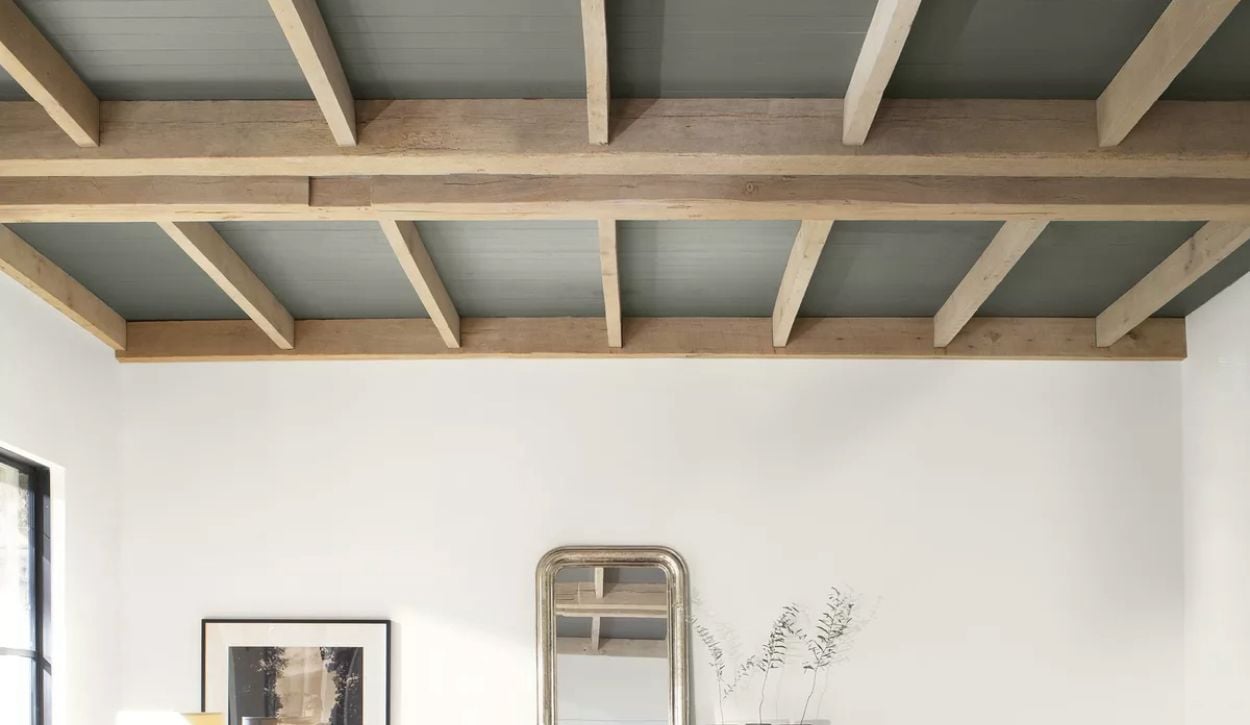 Ceiling painted in Benjamin Moore Chelsea Gray
Ceiling painted in Benjamin Moore Chelsea GrayPainting the ceiling area between the beams in a rich, cozy color like Chelsea Gray enhances the warmth of wood and adds a bit of drama.
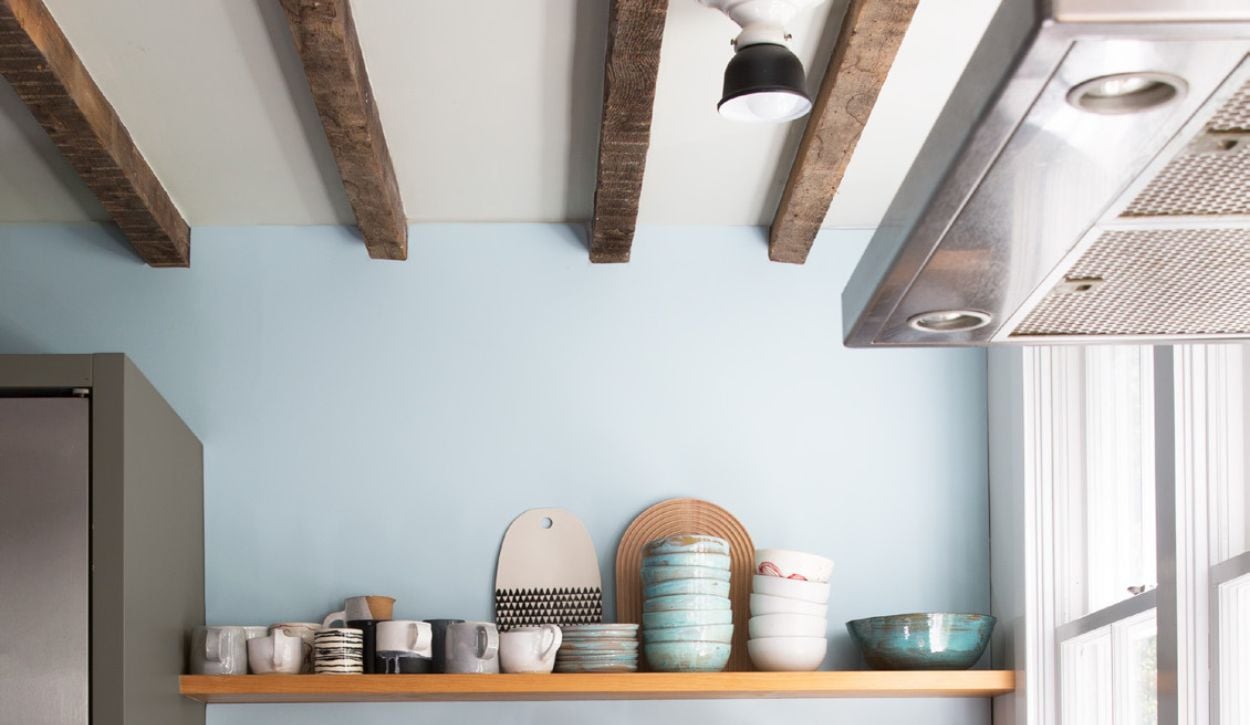 Kitchen painted in Benjamin Moore Stoneware CSP 245 (ceiling) and Intuition CSP-610 (accent wall)
Kitchen painted in Benjamin Moore Stoneware CSP 245 (ceiling) and Intuition CSP-610 (accent wall)If any of these design ideas caught your eye, order a paint sample today to start testing out your favorite colors! Ring’s End ships Benjamin Moore paint samples anywhere in the U.S.
Ceiling Paint Sheen Options
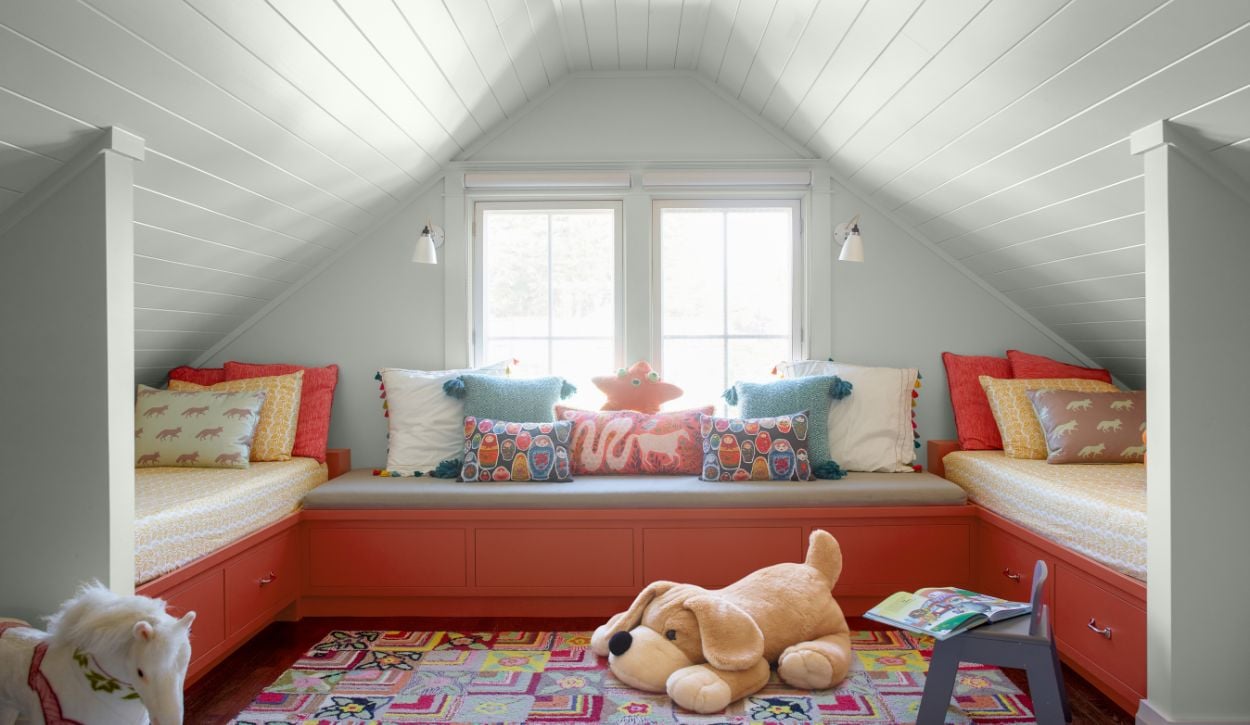 Playroom ceiling painted in Benjamin Moore Paper White OC-55, Satin
Playroom ceiling painted in Benjamin Moore Paper White OC-55, Satin After you have chosen a paint color that matches your interior design style, it’s important to consider the paint sheen. Let’s take a look at a few popular paint finishes for ceilings.
Flat: Flat paint is the most widely used type of finish for ceilings. It provides superior coverage, hides imperfections on the ceiling, and doesn’t catch your attention like high-gloss paint. Flat is also easy to apply without leaving lap marks, so it’s great for a DIY painting project.
Matte: Some people prefer matte paint for their ceiling, which has a slight sheen sometimes described as resembling velvet. If you are planning to use a darker color paint like gray, black, or navy, this is a great choice because it bounces light off a dark ceiling for a brightening effect.
Eggshell: Eggshell has a slight sheen that enlivens the surface. It can add subtle interest to a ceiling by reflecting the light in a room, drawing the eye up without overdoing the drama. Eggshell paint does take a little practice to apply without creating lap marks, but it’s worth the effort.
Satin: Satin is a low-lustre paint finish that has a subtle shine. This finish can be an excellent choice to highlight the woodwork on the ceiling without adding too much gloss, or to add a soft glow to a navy or black ceiling. A satin finish is also more durable (and easier to wash) than flatter finishes.
Semi-Gloss or Gloss: Painting a ceiling in semi-gloss or high-gloss is a trendy choice for your home design. These shiny finishes add drama and dimension to living spaces when paired with bold colors.
Check out our Guide to the Best Ceiling Paint to discover which paint products get the best results
4 Tips on How to Choose a Ceiling Paint Color
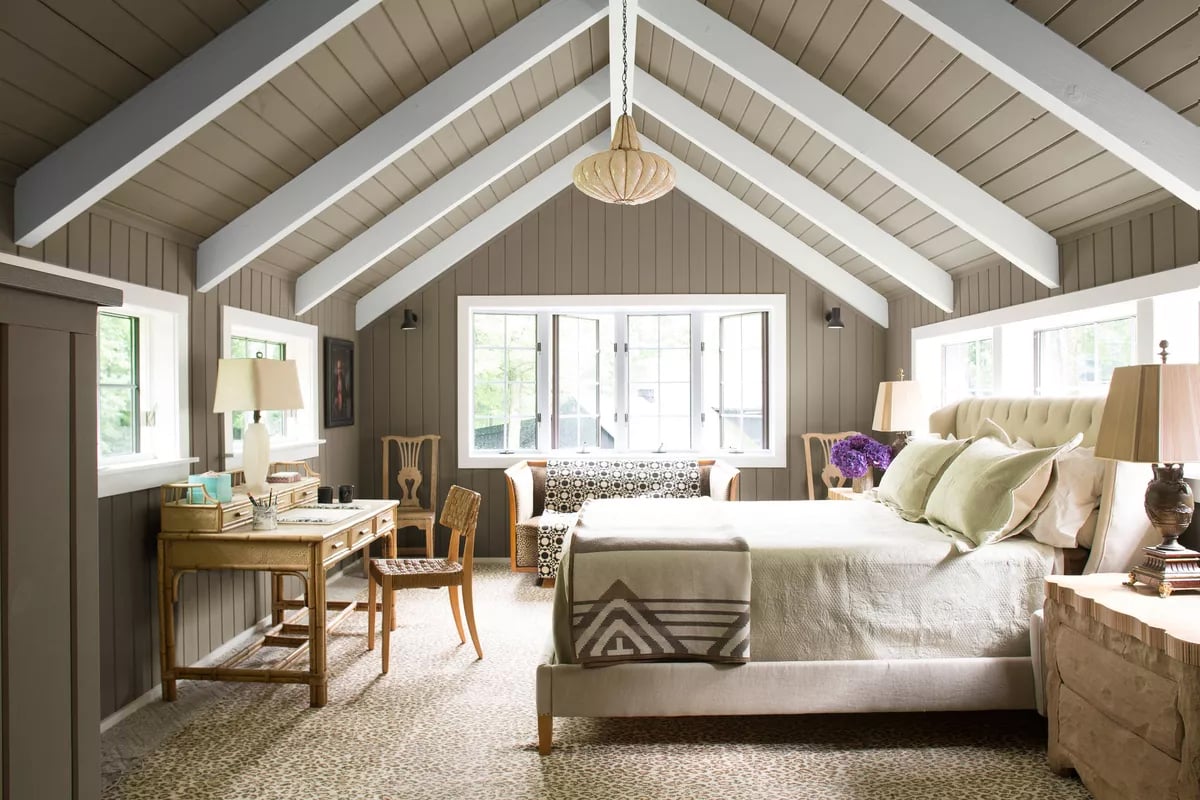 Bedroom ceiling painted in Benjamin Moore Copley Gray
Bedroom ceiling painted in Benjamin Moore Copley Gray Keep these tips in mind as you choose the best ceiling paint color for your project.
Consider the Light Sources in the Room
Ceiling and wall paint colors look different depending on the lighting in your room, and they might work with or against it. Take note of the sources of light in the room, including natural light from windows and artificial light from light fixtures like lamps and sconces.
Different types of light bulbs, from incandescents to fluorescents, also produce different lighting effects. Even the placement of your windows (for example, either north-facing or south-facing) will affect the way you perceive a paint color.
Consider The Light Reflective Value (LRV)
Every paint color has a light reflective value, or LRV, which refers to how much light it reflects or absorbs. LRV is measured on a scale of 0 (black) to 100 (white) and is generally listed on paint chip cards. Bright colors with an LRV of 50 or above reflect more light than they absorb, and typically create an airy look making a room feel larger, while those with LRVs under 50 absorb more light to create a space that feels more intimate, cozy, or moody depending on the shade of color.
Draw from Your Room’s Color Palette
One of the simplest ways to decide on a paint color for your ceiling is to choose a color that matches your room’s color palette. For example, if a room is filled with home decor that has warm undertones (like orange), then consider painting your ceiling a lighter color orange or yellow to continue that vibrant energy. If your room has jewel tones and you want a white ceiling, soften the contrast with a creamy white like Benjamin Moore Swiss Coffee instead of a bright white like Chantilly Lace.
Test Samples the Interior Designer’s Way
Before deciding on the color scheme for your room, be sure to test a sample of the paint color to make sure you like how the color looks at different times of day. To test paint samples like an interior designer, don’t paint the swatches directly on the wall or ceiling.
Instead, paint large poster boards with your favorite options — then move them around the room to observe the color and sheen in different lighting conditions.
Order Benjamin Moore Paint Samples Online at Ring’s End
We hope you’re inspired with just the right color for this important home improvement project! Whether you love DIY projects or prefer to hire professionals, with the right ceiling paint you can feel confident that you’ll love the end result.
Homeowners and professional paint contractors love Benjamin Moore paint colors for their vibrancy and color precision. With 3,500+ colors to choose from, it’s by far the largest selection on the market. Ring’s End ships Benjamin Moore paints and paint samples anywhere in the U.S. Order your favorite choices and we’ll have them delivered to your door!
For our top ceiling paint recommendations, check out our Guide to the Best Ceiling Paint. And if you’d like advice for finding the right paint color or paint product, don’t hesitate to contact our experts using our online chat or by texting (203)-PRO HELP. We’re here to help!

